AATA says AirRide shuttle service to Detroit airport saw strong ridership in first 2 weeks
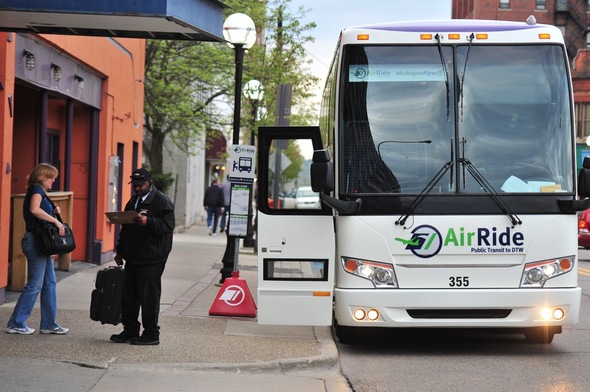
A woman hands her luggage to an attendant in front of the Dream Nite Club in downtown Ann Arbor as she boards the AirRide shuttle bus to Detroit Metro Airport at 7:30 p.m. Thursday night.
Ryan J. Stanton | AnnArbor.com
It welcomed 490 riders in its first six days and made 271 eastbound trips to the airport and 219 westbound trips to Ann Arbor, said Michael Ford, CEO of the Ann Arbor Transportation Authority. That's about 82 trips per day.
There were another 678 riders in the next seven days through April 14, including 336 eastbound and 342 westbound, Ford reported to the AATA governing board Thursday.
That's about 97 trips per day.
"We're continuing to see increases in the service," Ford said. "We're working with our community partners — the Convention and Visitors Bureau, the University of Michigan and others — to help continue to promote it. We think we have a good start. There's more work to do, but we're confident we're going to see even more increased ridership."
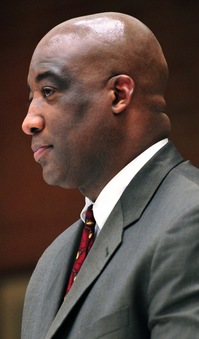
Michael Ford
Tickets have been offered at an introductory rate of $10 for a one-way trip. The regular adult fare will be $12 with a reservation or $15 without a reservation. The standard price for roundtrips will be $22.
With 12 daily roundtrips being offered, the numbers average out to 3.9 people on board for each eastbound trip to the airport and 3.6 people on board for each westbound trip back to Ann Arbor.
Ford said he's tried out the service himself and talked to others who have and the reaction has been positive.
"Everything's been smooth," he said. "People seem to be very pleased with the service."
Ford also gave an update on the AATA's countywide expansion initiative Thursday. He said a draft copy of a five-year transit plan is under review and should be available for board consideration at a special meeting on April 26.
He said the board will meet again on May 16 for a special retreat to talk about next year's budget.
As for a four-party agreement that lays the framework for creation of a new countywide transit authority, Ford said the AATA is working with legal counsel to navigate proposed modifications in preparation for presenting to the Ypsilanti City Council and county board for approval.
Ford also reported the expansion of the AATA's headquarters on South Industrial Highway continues to move along and concrete for the garage floor is being poured. Following that, painting and lighting will follow with a May completion date targeted.
As for the upcoming project to demolish and rebuild the Blake Transit Center, Ford said the agency is continuing to work on lowering the cost of the new facility by evaluating different materials and systems, while not compromising on the design or quality of the building. He said the agency hopes to break ground on the project in August.
Construction drawings have been submitted to the Ann Arbor Design Review Board. A public comment meeting is scheduled for April 26 at the Ann Arbor District Library.
In a written report, Ford gave an update on talks happening at the city level about building a new train station on Fuller Road to replace the Amtrak station on Depot Street.
Michael Benham, the AATA's special assistant for strategic planning, represented the agency on a recent tour of the Amtrak site. City Council Member Sabra Briere organized the tour for a group of residents concerned about moving Amtrak operations to Fuller Road.
"We and the city were there to explain the many difficulties that would be presented if the existing Amtrak site were used to try to accommodate future activity envisioned around rail service," Ford said in his report, raising concerns about traffic impacts.
"The combination of expanded Amtrak service and eventual commuter rail and high-speed rail presents a level of activity that would be extremely difficult to handle at the existing site."
The AATA's board also received an operations report Thursday showing the agency's unaudited financial statements for the first six months of the fiscal year through March 31.
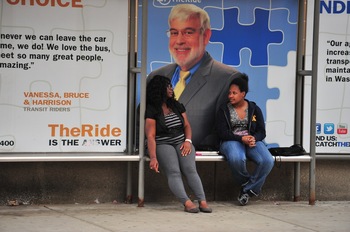
Two riders sit under a billboard featuring AATA Chairman Jesse Bernstein as they wait to catch a bus in front of the Blake Transit Center in downtown Ann Arbor Thursday night.
Ryan J. Stanton | AnnArbor.com
Overall revenues are 3.6 percent under budget at $13.7 million. That matches up with expenses, which are 4 percent under budget at $13.7 million. But that's still nearly $1 million more than the agency spent by this time last year.
The agency is averaging a $105 cost per service hour on its fixed-route bus service for the first six months of the year with 22.9 percent of those expenses paid by fares.
The AATA recently released a year-end audit for the fiscal year that ended Sept. 30. The agency ran a deficit budget last year and is doing so again this year.
The agency saw a $2 million drop in total net assets last year, dropping down to $45.7 million, with depreciation of capital assets being a major factor.
Unrestricted net assets dropped by about $263,000 to $15.6 million.
"That's more the deficit for the year," AATA controller Phil Webb said of the $263,000. "Because total net assets is a combination of capital assets, so that gets more complicated."
Operating revenues increased by $777,000 (16.9 percent) primarily due to fare increases, while total operating expenses increased by 3 percent.
Passenger fare revenues made up 21 percent of total revenues, up from 18.5 percent in the previous year.
The AATA's non-passenger fare revenues come from the Michigan Department of Transportation (27.8 percent), Federal Transit Administration (12.5 percent) and local sources (38.6 percent).
Local sources of revenue include transit millages levied by the cities of Ann Arbor and Ypsilanti and purchase-of-service agreements with Pittsfield, Superior and Ypsilanti townships. The AATA also makes money from bus advertising and interest on investments.
The AATA's expenses last year totaled $29.5 million, which was up from $28.7 million the year before and $27.6 million the year before that.
Broken down, last year's expenses included $19.4 million for operations, $3.3 million for vehicle and facility maintenance and $6.8 million for general administration.
The largest portion of all expenses — about $15 million — went to employee wages and fringe benefits, which account for more than 50 percent of all spending.
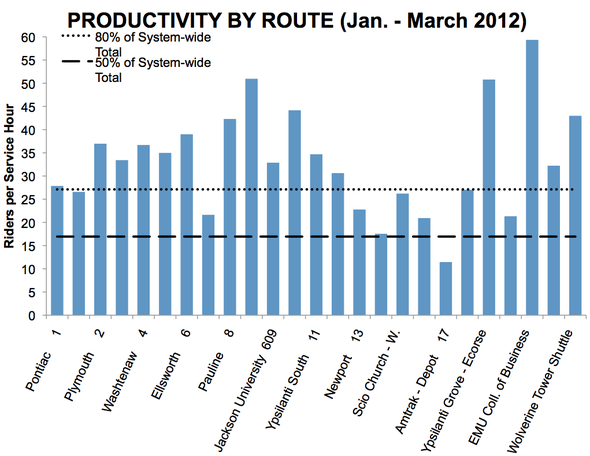
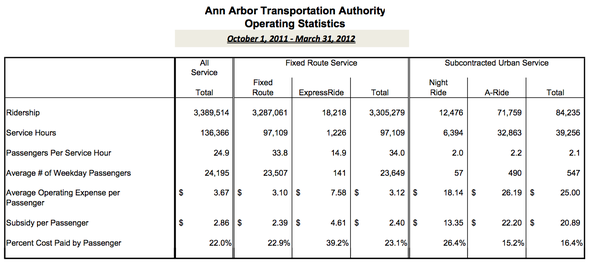
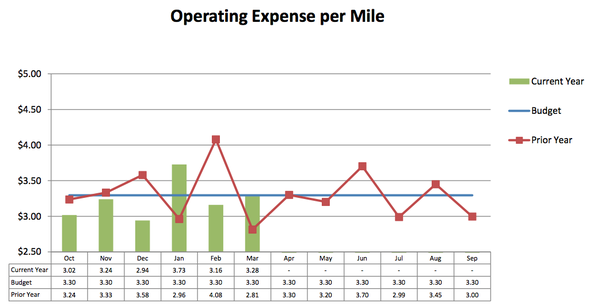
Ryan J. Stanton covers government and politics for AnnArbor.com. Reach him at ryanstanton@annarbor.com or 734-623-2529. You also can follow him on Twitter or subscribe to AnnArbor.com's email newsletters.


Comments
What?
Thu, Feb 28, 2013 : 5:42 p.m.
It's really awesome that we're seeing strong ridership from a new service. Usually they don't start off so well, but it seems that they're getting good reception from the community. Proves that a good section of the population actually needs a service like this to take them to the airport. I hope ridership continues going up for AirRide!
What?
Sun, Feb 17, 2013 : 12:55 a.m.
It's great that AATA is finally making a service that will take people to the airport. AirRide is a much needed service for people who cannot afford cab fare. The buses are nice and very big, and never overcrowded!
MyOpinion
Wed, Apr 25, 2012 : 8:59 p.m.
When I've ridden this service before it also includes riders coming from E. Lansing & Jackson. So, the buses don't just have the 3-5 passengers they've picked up in Ann Arbor. It also includes the riders from other locations. That makes for a long ride for the E. Lansing/Jackson folks, but given the price of parking at the airport, this is a great service as long as your trip is for more than a day or two.
DonBee
Sat, Apr 21, 2012 : 12:05 p.m.
Lets see 97, lets be nice and call it 100 trips a day. $15 per ride times 100 riders a day = $1500 a day. 365 days or $547,500 a year in revenue Ryan said the subsidy is $700,000 so the fares don't cover the subsidy. Then the bus company gets the first $250,000 in fares. So AATA gets $297,500 while laying out $700,000. Net loss to Ann Arbor tax payers $400,000. Not bad, only $400,000 tossed down the drain, via an out of state company. Of course local van services are now struggling and local jobs will probably disappear. Thank you AATA for supporting local jobs and companies! NOT!
What?
Tue, Nov 20, 2012 : 5:53 p.m.
Michigan Flyer certainly isn't an out of state company and neither is Indian Trails.
JoeNuke
Sat, Apr 21, 2012 : 12:51 a.m.
This service should be able to run without subsidy. The trouble with AATA is that it is insulated from accountability to voters and taxpayers. The council should hold public hearings when voting to approve mayoral appointees with this much authority to spend on behalf of taxpayers.
Peter Eckstein
Fri, Apr 20, 2012 : 7:47 p.m.
Someone (blahblahblah) suggested that the buses were travelling half empty. That was being awfully kind! The average numbers of passengers per ride are given at 3.9 and 3.6 depending on the dirction of travel. From the looks of the bus in the photo, it would probably hold ten times that number. When will the outgrow the notion that sending all-but-empty buses across the countryside is a good way to reduce traffic, cut costs, or save on fuel? And why doesn't AATA stop empire building and just create a website where service providers schedules and fees would be listed and users could rate their service (like Angie's list) that would help those wanting rides to the airport to find reliable private sector services. The cost would be minimal as against the massive subsidies this new service will obviously require--$1,843 per day by my quick arithmetic. So it could easily come to the limit of $700, 000 in taxpayer dollars that AATA has generously agreed to provide before it will review the matter.
Ken
Fri, Apr 20, 2012 : 11:05 p.m.
Peter, this is just the beginning; when AATA puts out the vote for County wide...........Fasten your seat belts!
Tom Whitaker
Fri, Apr 20, 2012 : 5:38 p.m.
12 round-trips per day made by these buses equals 24 segments per day. Six days times 24 segments per day equals 72 segments. 490 riders divided by 72 segments equals 6.8 riders per segment. How many seats are in each bus? Is this energy efficient? Why not use vans? How much is each segment costing the taxpayers? How much is being spent on marketing and nearly-free parking for Air-Ride passengers in the downtown parking structures? What is the benefit to society here that requires spending all this money? Indian Trails ran the airport service privately for several years without any tax money. Adding a stop to Blake could have been worked out. Adding a few more runs (if in demand) could also have been worked out. Why the need for a government take-over and subsidy of this apparently successful private enterprise?
Dog Guy
Fri, Apr 20, 2012 : 4:50 p.m.
I remember when we were " citizens" and not just "taxpayers". Ah, the good old days!
Ryan J. Stanton
Fri, Apr 20, 2012 : 3:46 p.m.
Info on the costs: AATA has contracted with Indian Trails (Michigan Flyer) for two years at a cost of $2.56 per service mile. The total cost is not to exceed $700,000 per year without the consent of AATA's board. Under the public-private partnership, Indian Trails retains the first $250,000 of fares collected each year of the contract. Fares collected in excess of $250,000 each year are to be used to offset the cost to AATA of the AirRide services.
Tanzor
Fri, Apr 20, 2012 : 2:35 p.m.
Am I reading this correctly? 271 eastbound trips + 219 westbound trips = 490 trips total. The service "welcomed 490 riders" that's an average of 1 rider per trip? Strong ridership, you've got to be kidding me. What we have here is very strong waste of tax payer money by AATA which is over 80% subsidized. What was the actual cost for the "82 trips per day"? AATA must start focusing on operating efficiency and fiscal responsibility rather than the insane quest to continually expand the scope of their services at the expense of tax payers.
Joe
Fri, Apr 20, 2012 : 3:57 p.m.
No, you're not reading it correctly.
pest
Fri, Apr 20, 2012 : 1:47 p.m.
Just curious - how many people will ride the tax-payer subsidized bus to and from the airport once the students are gone for the summer>
Ken
Fri, Apr 20, 2012 : 11:02 p.m.
As long as the U-M and the DDA continue to pay (our TAX MONEY) to AATA for these "transit alternatives" AATA will continue to operate the service @$105 to $107 per hour!!
Ron Granger
Fri, Apr 20, 2012 : 1:32 p.m.
How much do taxpayers subsidize this bus service? Should taxpayers be competing with private enterprise, when good private options are available?
blahblahblah
Fri, Apr 20, 2012 : 12:58 p.m.
There's nothing GREEN about, tearing down and rebuilding FULLY functioning bus and train stations, sending half empty buses 50 miles round trip to the airport, etc., etc... all at the taxpayer's expense!
Ken
Fri, Apr 20, 2012 : 11 p.m.
We must be ready for County wide bus service.
a2grateful
Fri, Apr 20, 2012 : 12:38 p.m.
Math results of first six days: 490 riders / 6 days = 82 riders / day. . . 12 round trips / day. . . 6.8 riders / round trip, avg. Or, 24 single trips /day. 3.4 riders / single trip, avg. Math results of next seven days: 678 riders / 7 days = 97 riders / day. 12 round trips / day. 8 riders / round trip, avg. Or, 24 single trips / day. 4 riders / single trip, avg. 3.4 - 4 riders / single trip = Strong ridership? Must be the new math of public-sector subsidization.
Craig Lounsbury
Fri, Apr 20, 2012 : 12:18 p.m.
I will toss out the notion that jet passenger planes are not very "carbon friendly". Given that Ann Arbor's politicians like to pretend to care about the environment shouldn't they be philosophically opposed to encouraging plane travel?
Anthony Clark
Thu, Apr 26, 2012 : 2:25 a.m.
Do you have any facts to back up your assertion that passenger plane travel is less environmentally friendly than other types of travel? Just asking.
DonBee
Fri, Apr 20, 2012 : 11:54 a.m.
Given the number of round trips, a van would be a more environmentally friendly vehicle. It looks like with 97 trips (passengers a day) that a 15 passenger van would hold everyone that wants to ride on each trip.
DonBee
Fri, Apr 20, 2012 : 5:16 p.m.
rs - They are averaging 4 people per bus, that is a lot of metal to move for 4 people. A 15 passenger van would be more environmentally friendly.
rs
Fri, Apr 20, 2012 : 2:27 p.m.
Again, you have to understand the what the AATA is considering a "trip" in this article. Basically they are saying they gave 97 people a trip to the airport day, not they they are taking 97 buses to the airport everyday.
Kara H
Fri, Apr 20, 2012 : 1:15 p.m.
I'm with @DonBee on this one. I've often wondered that about most of the AATA runs and routes--why run big empty buses on all of them? Why not smaller vehicles and vans?
Brad
Fri, Apr 20, 2012 : 11:43 a.m.
Of course it's popular. The private sector can hardly compete with a service that is subsidized to the tune of 80% (or whatever) by the taxpayers.
Ken
Fri, Apr 20, 2012 : 10:58 p.m.
OK, 21% fares and 79% subsidy
Joe
Fri, Apr 20, 2012 : 4:07 p.m.
"Passenger fare revenues made up 21 percent of total revenues..."
DonBee
Fri, Apr 20, 2012 : 11:53 a.m.
According to AATA's own report - 16 percent fares and 84% subsidy.
Craig Lounsbury
Fri, Apr 20, 2012 : 11:33 a.m.
I live in Ann Arbor and I pay property taxes, a portion of which goes to AATA. I don't mind that. I don't mind subsidizing some level of public transportation within the city and to and from the Ypsilanti area. But I'm not sure I like subsidizing peoples rides to the airport. If your on a business trip, you can write off as an expense AND build it in to the cost of doing business. If your flying for "fun" (vacation) I don't want to subside your fun.
Joe
Fri, Apr 20, 2012 : 3:56 p.m.
I'm fully in support of public transportation, and I also agree with your sentiment. In this case, I think fares should be covering the cost. Otherwise this works out to a subsidy for the airlines. Air travel is part of the problem with transportation in this country, not the solution. It's highly inefficient when compared with rail travel.
rs
Fri, Apr 20, 2012 : 11:33 a.m.
They are considering each person as a trip. Using their terminology, that fact that I carpooled to work with 2 other people this morning means I made 3 trips to work. Its just a poorly worded article.
Unusual Suspect
Fri, Apr 20, 2012 : 11:50 a.m.
Aye, it should be a something like a "person trip."
Craig Lounsbury
Fri, Apr 20, 2012 : 11:24 a.m.
How many times a day did the bus make a round trip? Did i miss that in the story?
Joe
Fri, Apr 20, 2012 : 3:53 p.m.
Yes you did.
RRinAA
Fri, Apr 20, 2012 : 11:08 a.m.
When I read "271 eastbound trips to the airport and 219 westbound trips to Ann Arbor," my first thought is "I wonder what happened to the 52 buses that didn't make the westbound trip?" Just sayin'. Seriously though, this is a great service that I would use if I traveled more often. The prices beat out the private fares ($50) by a wide margin. I hope it survives.
Peregrine
Fri, Apr 20, 2012 : 3:39 p.m.
Which private van service charges $15 one way to/from the airport? One service that I'm aware of has prices nearer $30 each way. If you have three in your party you can get it down to about $15 per person.
a2grateful
Fri, Apr 20, 2012 : 12:52 p.m.
Private vans pick you up at your house . . . when you want . . . driving you to where you want. The drivers carry your luggage. Private service is much better value.
DonBee
Fri, Apr 20, 2012 : 11:52 a.m.
RRinAA - Private van service is typically $15 each way, door to door. Private vans will typically pick you up in a 15 minute window.
Craig Lounsbury
Fri, Apr 20, 2012 : 11:25 a.m.
I wondered that too. But "eastbound trip" i believe refers to a passenger, not a bus.
A2comments
Fri, Apr 20, 2012 : 10:33 a.m.
How does the airport bus make money with ONE PERSON on the bus. Eyeballing the numbers that's what I see.
Joe
Fri, Apr 20, 2012 : 3:52 p.m.
Or you could read the article: "With 12 daily roundtrips being offered, the numbers average out to 3.9 people on board for each eastbound trip to the airport and 3.6 people on board for each westbound trip back to Ann Arbor." Eyeballing the numbers... that's what I see.
David Frye
Fri, Apr 20, 2012 : 2:16 p.m.
The article should have made clear that the buses make 24 trips per day (12 in each direction). The totals given in the article ("271 eastbound trips to the airport and 219 westbound trips to Ann Arbor") are for "passenger trips," not trips by the buses, so of course they add up to 1 person per trip, by definition. Divide the passenger trips by the number of bus trips, and you get an average of 3.4 passengers per bus in the first week and 4.0 in the second. It's a start.